an architectural deep time message to humanity


an architectural deep time message to humanity

stone sampling through geological epochs, and thoughts on monumentality and deep time communication.
Maria Michelaki
an architectural deep time message to humanity
Maria Michelaki
Supervisor: Filip Mattens
Co-supervisor: Arnaud Hendrickx
2023-2024
Studio Sv-On-Po-Gi
KU Leuven Faculty of Architecture
Campus Sint-Lucas Brussels


Abstract
This project began as an attempt to materialize my inner desires to create something that would last forever and was later shaped by my reflections on the Onkalo nuclear waste facility.
Onkalo is being built to secure the biggest hazard humankind has ever created. Its makers claim that it will remain unopened for 100,000 years. This underground “hiding place” contains the possibility of total annihilation of humankind and all life on Earth. Much of my interest was focused on the question of how this danger should be communicated to future beings, even when civilizations might disappear, to ensure the sealing of Onkalo for millennia.
The Memorial of Life is created as a contrast to Onkalo: not to hide away danger, but to create a hidden message to the future, as proof of life on this giant rock in space.
Throughout my research on how to create a monument, I had to contemplate questions that have concerned the human psyche for eons: What drives us to leave our mark in this world? What compels us to sign our names on stones that existed long before us and will continue to exist when we cease to even be a memory? And, when we see messages from the past, how is it that they speak so humanly to us?
The Memorial of Life is the product of this contemplation. Located on the shore of lake Kourulammi in Finland, marked by a monument, there is an underground cavity, carved in the bedrock. This cavity serves as a moon observatory and a vault for exhibiting a curated selection of stones, formed throughout the different epochs of Earth’s geological history, representing the long life of this planet and its ever-changing, but always connected, origin and future.
My supervisors, Filip Mattens & Arnaud Hendrickx, for encouraging me to think beyond conventional boundaries, and for their supportive and relaxed approach, that respected my own ideas and helped them flourish.
My family, Nikos, Ritsa and Giannis, for supporting all my dreams, always.
My friends, Akif, Aravind, Arumi, Clelia, Duvi, Leyla, Micha, Mita, Vinul, whose paths crossed mine and changed me forever, with whom I shared this new life, and whom I will have forever in my heart, even if life takes us to different places.
Lazaros, for being my geology consultant and enduring my relentless questions.
Charis and Shenzi, for being my biggest believers, through the thick and thin, in laughter and in tears. Without you this wouldn’t have been possible.
To all of you, Thank you.
“Human civilization has evolved to the point at which we have begun consciously sending messages into the far future. How should we communicate who we are, what we know, to as-yet-unmet intelligent beings elsewhere in both time and space? And what information will we leave to Earth’s occupants a million years hence? How can we address an unknown destiny in which human culture may no longer exist?”
-Gregory Benford

The passage of time is an ever-present, relentless force that shapes our existence and the world around us. In the face of this inexorable flow, humanity has always sought to leave its mark, to communicate across the millennia, and to create lasting testaments to our presence on Earth. This desire to transcend time is at the heart of the Memorial of Life project, an endeavor inspired by my reflections on how we communicate with the distant future through architecture.
Memorial of Life serves both a future and a current purpose. In our time, it functions as a full moon observatory and a vault exhibiting a curated selection of stones. Celestial events have shaped the orientation of monumental architecture for millennia, thus this project, by learning from the wisdom of the past, focuses on the position of the full moon on the day of the spring equinox for the next thousands of years. The stones, each formed in a different geological epoch, are collected from diverse locations around the globe. This collection not only showcases the vast timeline of Earth’s history, but also symbolizes the interconnectedness of our planet’s geological heritage.
In the future, the Memorial of Life will stand as a structure that serves as proof of life on this planet, an architectural testament to our existence. It is designed to speak to our deepest, subconscious understanding of human aesthetics.
This monument will endure the passage of time, preserving the legacy of humanity and the natural history of Earth within its walls. And as the time passes, the monument and its contents will offer a message to future beings —whether human or otherwise— about who we were and what we valued. This project’s aim is to leave a lasting, tangible legacy that communicates the essence of humanity across the ages.

The island of Olkiluoto, located in the archipelago of Finland, is a site of unique geological significance due to its stability, shaped by millions of years of geological events.
Olkiluoto, as we know it now, is the result of nearly 2 billion years of geological transformations that began with the collision of two microcontinents. This collision buckled the previously linear Fennian orogeny. Over time, the mountains eroded, becoming less steep and transforming what was once rocky and mountainous terrain into a plain.
The eroded materials were washed into the sea, altering the load on the lithosphere. This phenomenon caused a slight uplift of the land and sedimentation of the oceanic plate, ultimately resulting in the formation of the Baltic Archipelago, with its numerous islands and shallow waters.
The land continued to rise. Following the last ice age, the enormous mass of ice began to recede, relieving a large area of significant pressure. This post-glacial rebound further eroded the mountains, shaping the Finland we recognize today.
These processes have resulted in a biosphere where the hard bedrock, composed of a combination of metamorphic materials, emerges from the sea. On top of these islands, a thin layer of organic matter has been accumulating since the end of the last ice age. In many places, this layer only reaches a thickness of 10-60 cm.
However, through constant processes of washing and blowing away, followed by re-accumulation with new organic matter, creating a very rich and diverse soil.
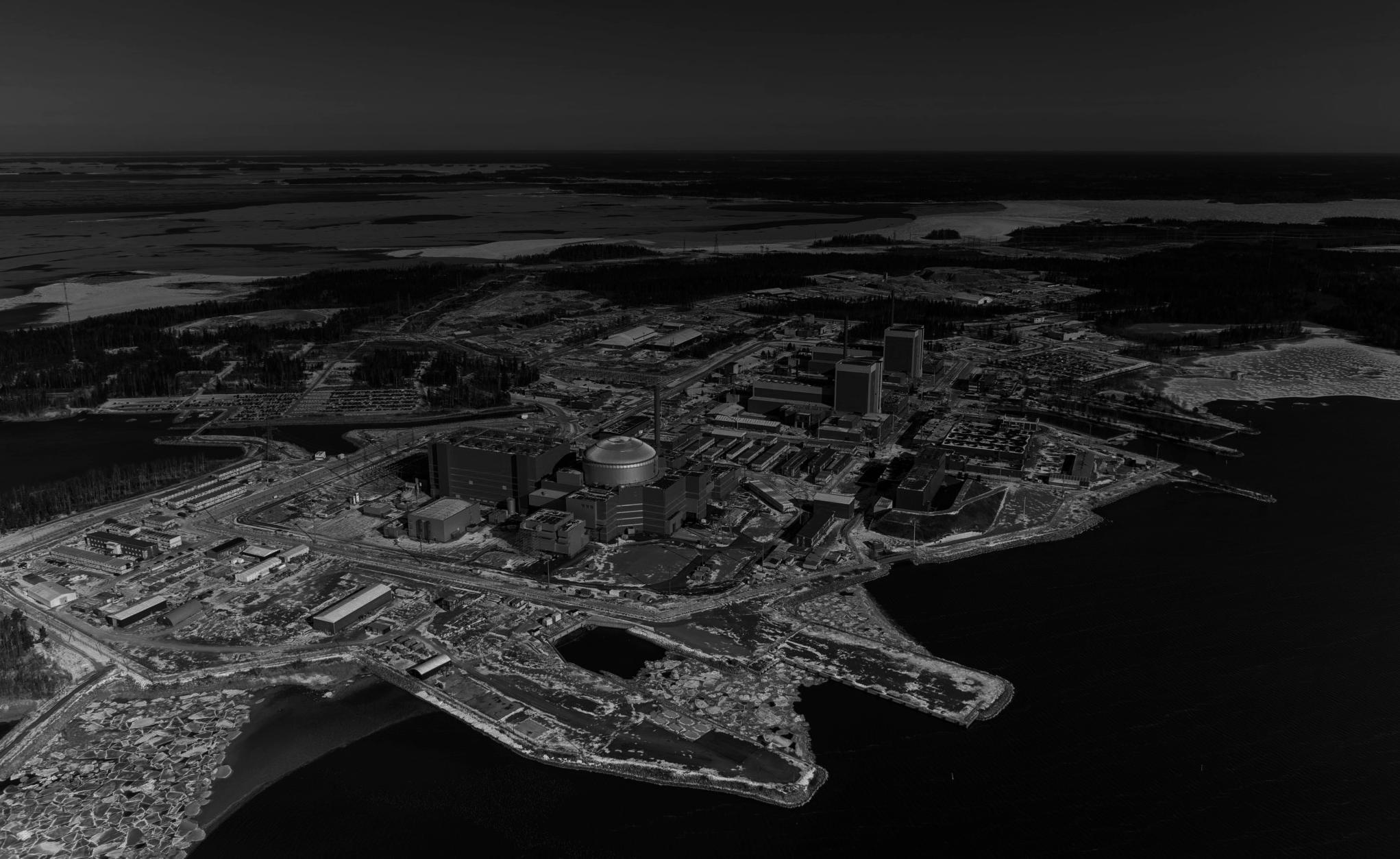
Onkalo in Finnish means “cavity”. That was the name given to the Underground Nuclear Waste Repository located in Olkiluoto, Finland.
Buried deep within the solid bedrock of Olkiluoto Island, Onkalo was conceived to address the complex and enduring challenge of safely and responsibly disposing of high-level nuclear waste.
This subterranean facility is the result of collaborative efforts between the Finnish nuclear industry, led by Posiva, a specialized company established for this purpose, and the Finnish government.
The fundamental objective of Onkalo is to secure Finland’s spent nuclear fuel for 100.000 years -as long as the nuclear waste remains active-, providing a protective shield against both environmental factors and the potential implications of human interference.
Onkalo attempts to bring a solution to the global challenge of managing nuclear waste responsibly, reflecting the broader ethical commitment to safeguarding future generations from the hazards associated with nuclear energy.
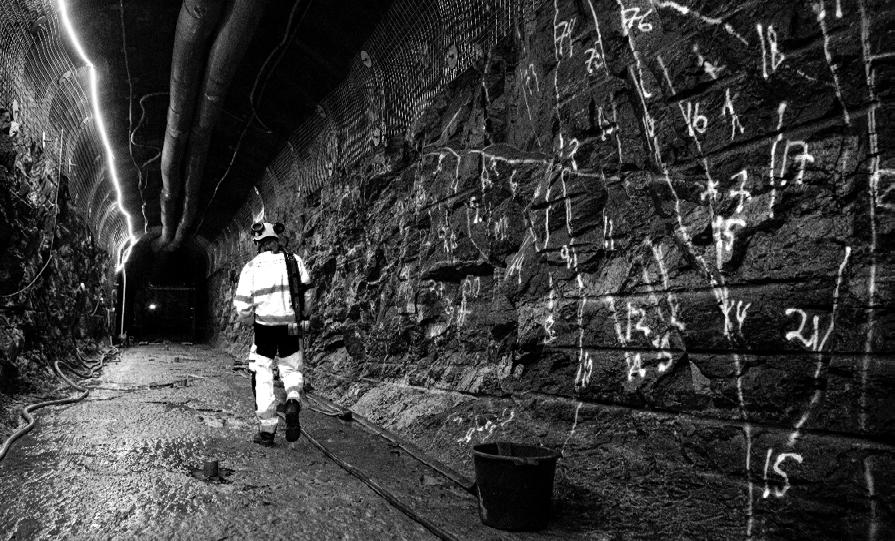
img 02. Inside Onkalo

“This tunnel feels like a time capsule sometimes. You enter when it feels like summer and come out on a freezing cold day, making it seem as if a whole season has passed while you were inside.”
-Sami Savonrinne, worker at Onkalo
This sentiment, I think, comes from how we, as humans, perceive time. Through phenomenological impulses one becomes aware of themselves and their environment. So what does it mean to go into a place that is unchanging, and completely stable?
According to Von Uexkull the body is the synthesizer of meaning, the world can only be understood through the senses of the organism. This means that the sensory organs between an input and an output essentially define how a being experiences its ‘world’. That is the reason why we are unable to comprehend the gigantic time spans needed for our world to be formed and changed, named deep time, geological time, or cosmic time. 1 2
As Gregory Benford explains, humanity has managed to minimize distances and sizes with technology. We are now able to receive a radio transmission of Voyager 1, 23.381 billion km away from earth (2022), and we can look into the way the DNA is wrapped around different types of proteins and predict genetic mutation. But our reach to the future is far more limited. 3 4
1 Von Uexküll, Jakob. A Foray into the Worlds of Animals and Humans: With A Theory of Meaning. Translated by Joseph D. O’Neil. Minneapolis: University of Minnesota Press, 2013
2 “Deep Time,” n.d. https://anthropocene.univie.ac.at/resources/deeptime/
3 https://en.wikipedia.org/wiki/Voyager_1
4 Benford, Gregory. Deep Time: How Humanity Communicates Across Millennia New York: Harper Collins, 1999. p.13-14
In the 1970s, the Pioneer 10 and 11 carried plaques with symbols and inscriptions in an attempt to communicate to intelligent life our human existence. These plaques were deep time messages placed in the preserving vacuum of space, perhaps to be read billions of years from now. Deep time messages placed in proximity to us have lower chances of surviving, due to the instability of our planet. But our human nature has embedded in it this global impulse to leave its mark on this place, a message communicating our existence, our culture, our ways. It is perhaps our attempt to go beyond our mortality and extend our existence.
That raises the question: if 10.000 years back is the maximum time human consciousness has been detected, how can we expect the message of Onkalo’s potential hazard to survive for 100.000 years, when languages, symbols, culture may have completely vanished?

While innovative proposals by the Human Interference Task Force (1981) have been considered, it remains a challenging endeavor. Universally understood signals will lose their meaning when removed from their cultural context. Take for example, the Japanese reading comics right to left, or a drawing of a skull that indicated danger and death in the past and now, just centuries later, it can be found on children’s t-shirts.
Other suggestions, such as genetically modified cats, engineered to fluoresce in the presence of radiation, accompanied by creating superstition around them, or the idea of an “atomic priesthood” (img 06) passing knowledge through generations, seem inherently unreliable methods of communication. Hostile architecture, and specifically the design of Michael Brill (img 05), consisting of the plot being filled with concrete, dystopian spires to discourage future humans, was also contemplated.
However, understanding the complexities of the human nature, this approach could create an intriguing landscape that would attract potential explorers, especially since it was even considered to be the next miracle of the world.
For Onkalo, the chosen strategy was radical: to entirely conceal the repository beneath what is presumed to be impenetrable ground and hope time will fade all knowledge of its existence, a solution that grapples with the challenge of warning the distant future in an uncertain and ever-evolving world. 5 6 7 8
5 https://en.wikipedia.org/wiki/Pioneer_plaque
6 https://www.theatomicpriesthoodproject.org/
7 https://99percentinvisible.org/episode/ten-thousand-years/
8 Madsen, Michael, dir. Into Eternity. Atmo Media Network, 2010. Film.
Ten thousand years ago humans evolved from hunter gatherers to invent agriculture, which lead to their numbers rising. Soon came cities, and with cities came more permanent structures as tributes to their deities and their dead. These artifacts that function as deep time messages carry information throughout millennia about cultures that believed they have accomplished something great.
However, we must not forget that, in the present, due to our great removal from those times, we can only speculate their deeper motives through the prism of our own culture.
Yet, it is this lost meaning of many of these that intrigues us into theorizing and engaging into deeper research about them.
I decided to explore these ancient monuments, in order to identify their key characteristics and recognize what can possibly connect them across time, space, and culture. By analyzing them, I sought to draw inspiration for the Memorial of Life.
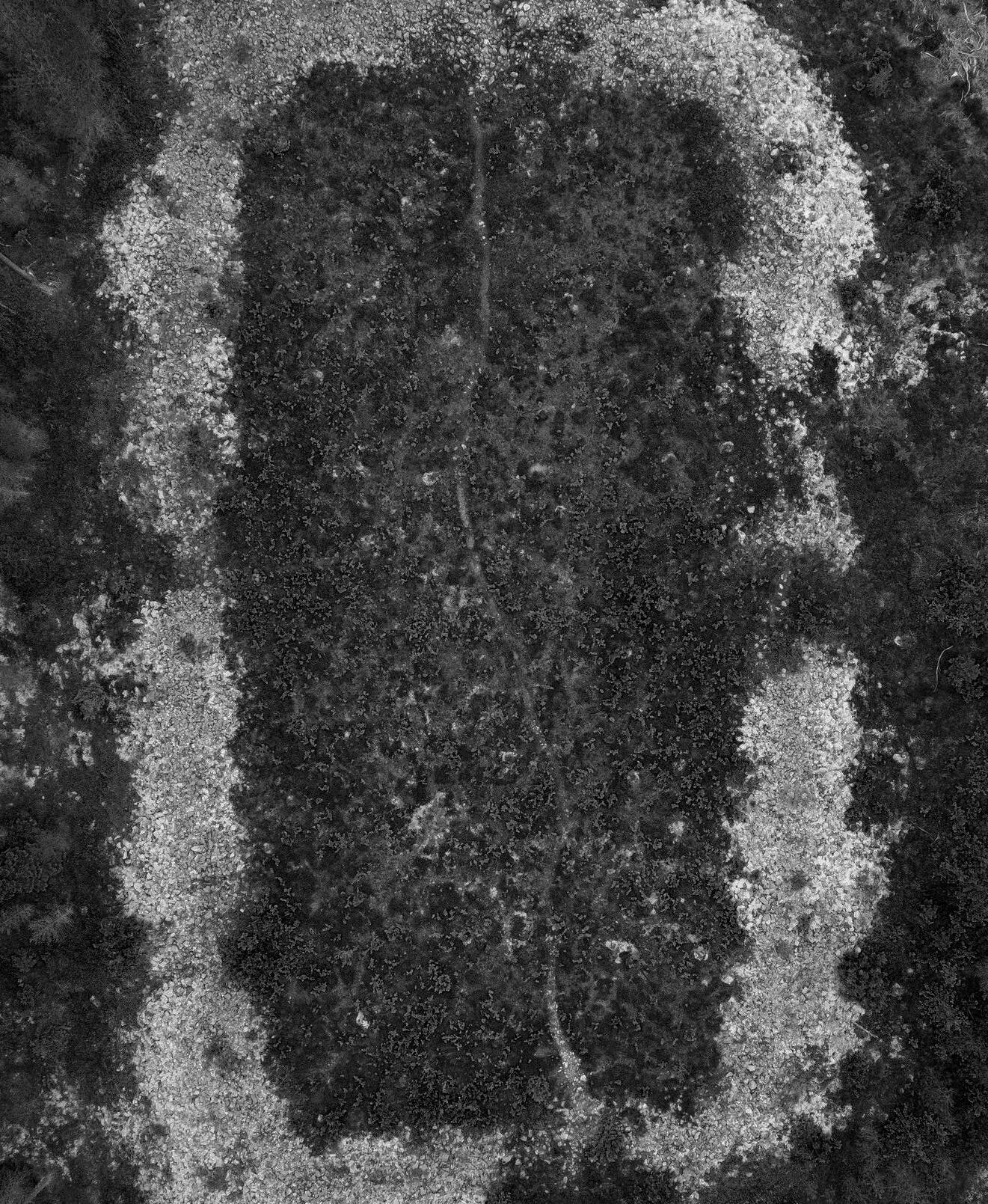
For 3.800 years, the Pyramids of Giza have been the highest structure known to mankind. Constructed around 2580-2560 BC out of limestone and granite, the Great Pyramid was made to stand at 146 meters high. Today what remains of them is but their inner core, as their gold capstones and the precious limestone that covered them has been repurposed. Still these massive structures inspire awe, especially when we understand the advanced geometrical and astronomical knowledge that was part of their construction, with their bases creating almost perfect rectangles and their orientation leading towards true North. These man-made mountains were built to ensure the pharaohs’ safe passage to the afterlife and demonstrate their divine status. 9 10
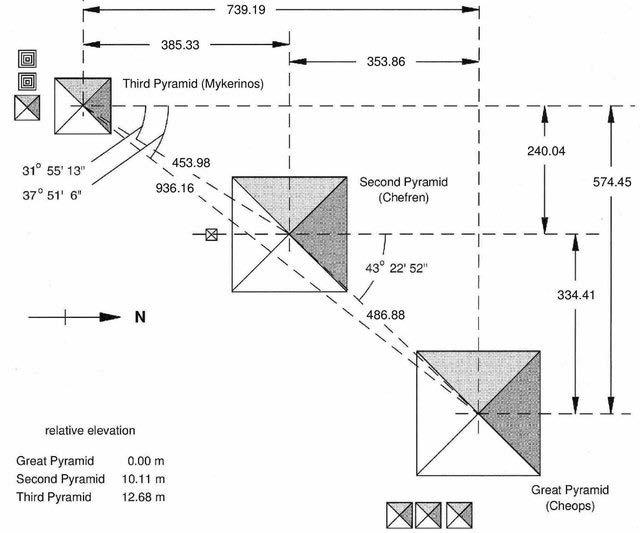
img 06. Alignment of the Giza pyramids
9 Benford, Gregory. Deep Time: How Humanity Communicates Across Millennia New York: Harper Collins, 1999. p.28
10 https://en.wikipedia.org/wiki/Great_Pyramid_of_Giza
Similarly, the Pyramids of the Incas, built thousands of years later (1450 CE), in a completely different part of the world, also held religious and ceremonial significance. They were built from precisely cut stone blocks and held funtions such as offerings and sacrifices to the Gods. Here the orientation doesn’t follow the true North as in Egypt, but is dictated by the sunrise during the days of solar zenith transit. The solar zenith is argued to have held religious importance for the Incas culture as it signified the annual start of the argicultural period. 11 12
Travelling further in time and space, in Stonehenge (3100BCE-1600BCE), the Altar stone is illuminated during the first minutes of the summer solstice. So, it is another stone structure whose orientation is defined by celestial elements or events. 13
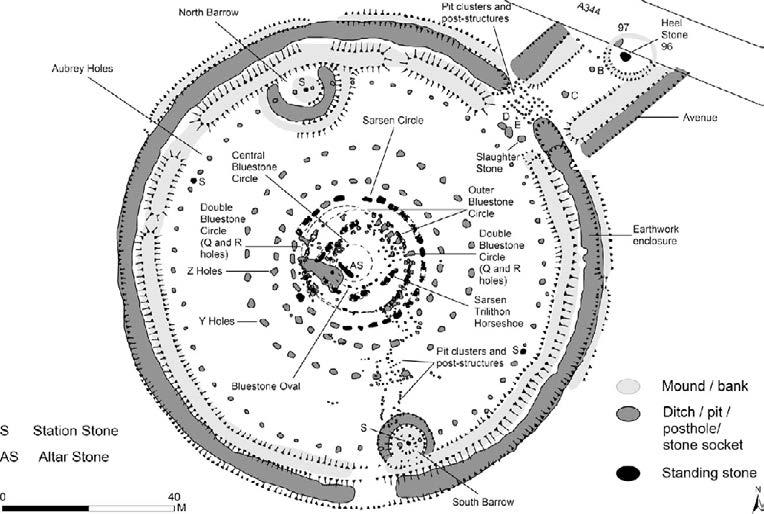
img 07. Plan of the site of Stonehenge
11 Ziółkowski, M., Abuhadba, J., Hogg, A., Sieczkowska, D., Rakowski, A., Pawlyta, J., & Manning, S. (2020). WHEN DID THE INCAS BUILD MACHU PICCHU AND ITS SATELLITE SITES? NEW APPROCHES BASED ON RADIOCARBON DATING. Radiocarbon, 63, 1133 - 1148. https://doi. org/10.1017/RDC.2020.79.
12 Donald A. Slater, Linking Cave, Mountain, and Sky: A Subterranean Observation Point for the Sunrise on the Day of Solar Zenith Transit in Yucatan, Mexico, 2014
13 G. Terence Meaden, Stonehenge and Avebury: Megalithic shadow casting at the solstices at sunrise,Journal of Lithic Studies 4, p. 39-66, 1970
Another connection between these sites has to be the significance of the material with which they are built. Stone is the persistent material that unquestionably survives enormous time scales.
The Giant’s Churches of Finland are prehistoric stone enclosures. They were built the same period (3000BCE) in multiple coastal locations and their size varies from 12 to 60 meters in length. Their function, similarly to Stonehenge, has been a reason for debate for decades, with specialists arguing between dwellings, burial sites, temples, fortresses, natural formations, giant cold stores for seal meat and hunting enclosures. What we know for sure is that multiple of these structures’ entrances are oriented towards solar events happening on the solstices and the equinox days.
These monuments, despite their geographical and cultural diversity, reflect advanced understanding of astronomy and engineering, and humans’ attempt to connect with the cosmos and establish themselves in this world. Their endurance through such long periods of time has given them the function of deep time messages. Through them, we can connect to the distant past and the humans who walked the same earth as we do, thousands of years ago and know of their existence, even understand aspects of their lives.
The common thread among the aforementioned monuments -but also others like Watson Brake (USA, 3500BCE), Newgrange (Ireland, 3200BCE), Göbekli Tepe (Turkey, 9600BCE)- is their stone construction and their orientation towards celestial events.
During my reasearch, I concluded that these timeless principles were the key to my design of the Memorial of Life.

This Memorial of Life started from my attempt to comprehend the timeframe in which Onkalo has to operate. This drove me into a rabbit whole researching the concept of deep time and how architecture can serve the purpose of a deep time message.
Originally, the design was a monolithic shape, oriented towards the summer solstice sunset. It would be placed in proximity to Onkalo in order to accentuate the irony of creating a memorial to celebrate life close to a possible hazard of total annihilation.
As the ideas started solidifying around the design, I began to explore how to make the monument “speak” to the human senses, how to make it feel familiar and evidently made by humans, even to someone who would be completely distanced from our current culture. At the same time, I wanted to honour the practice of the past and design my project in a way that would include creating focus points to special celestial events.
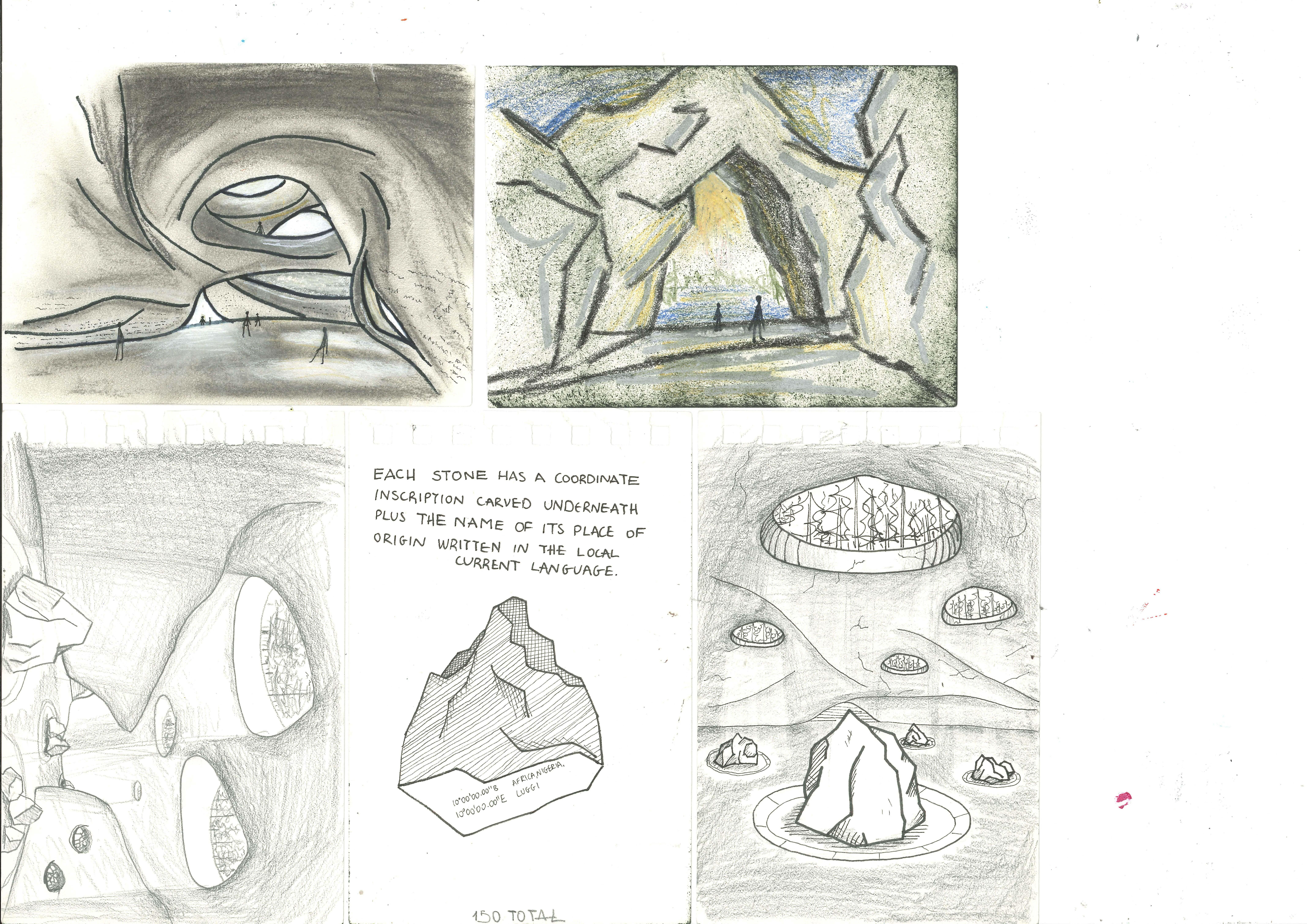

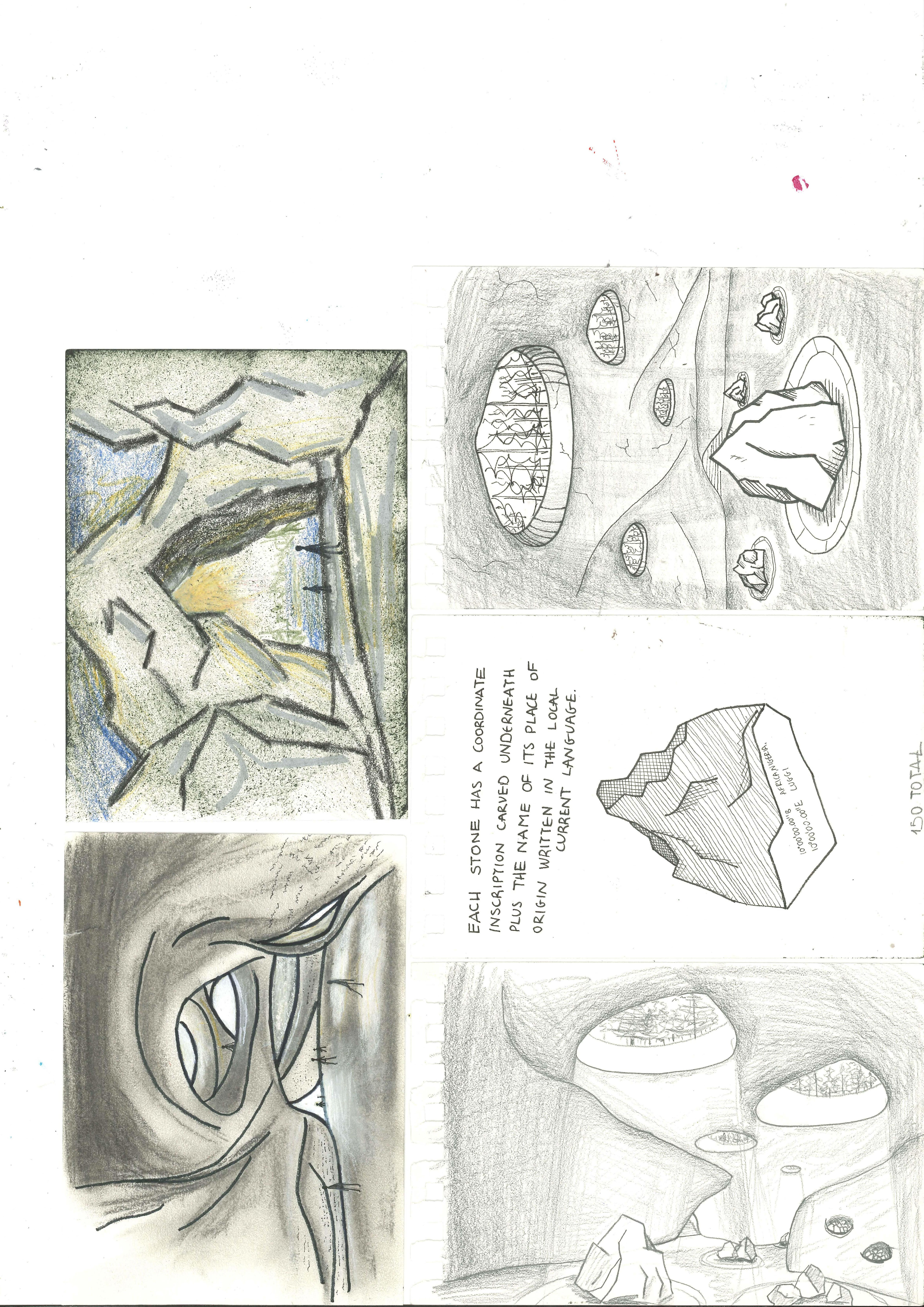
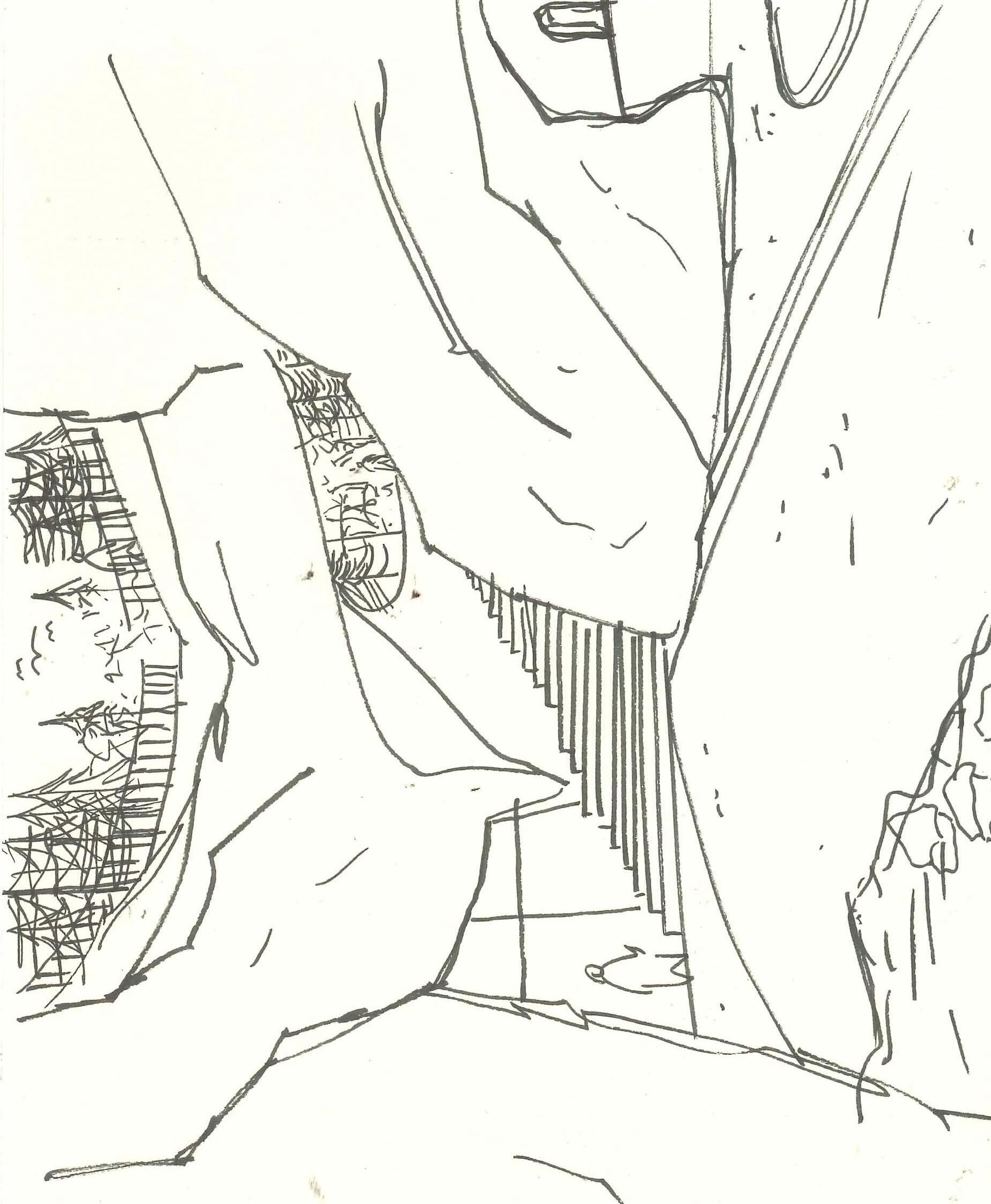

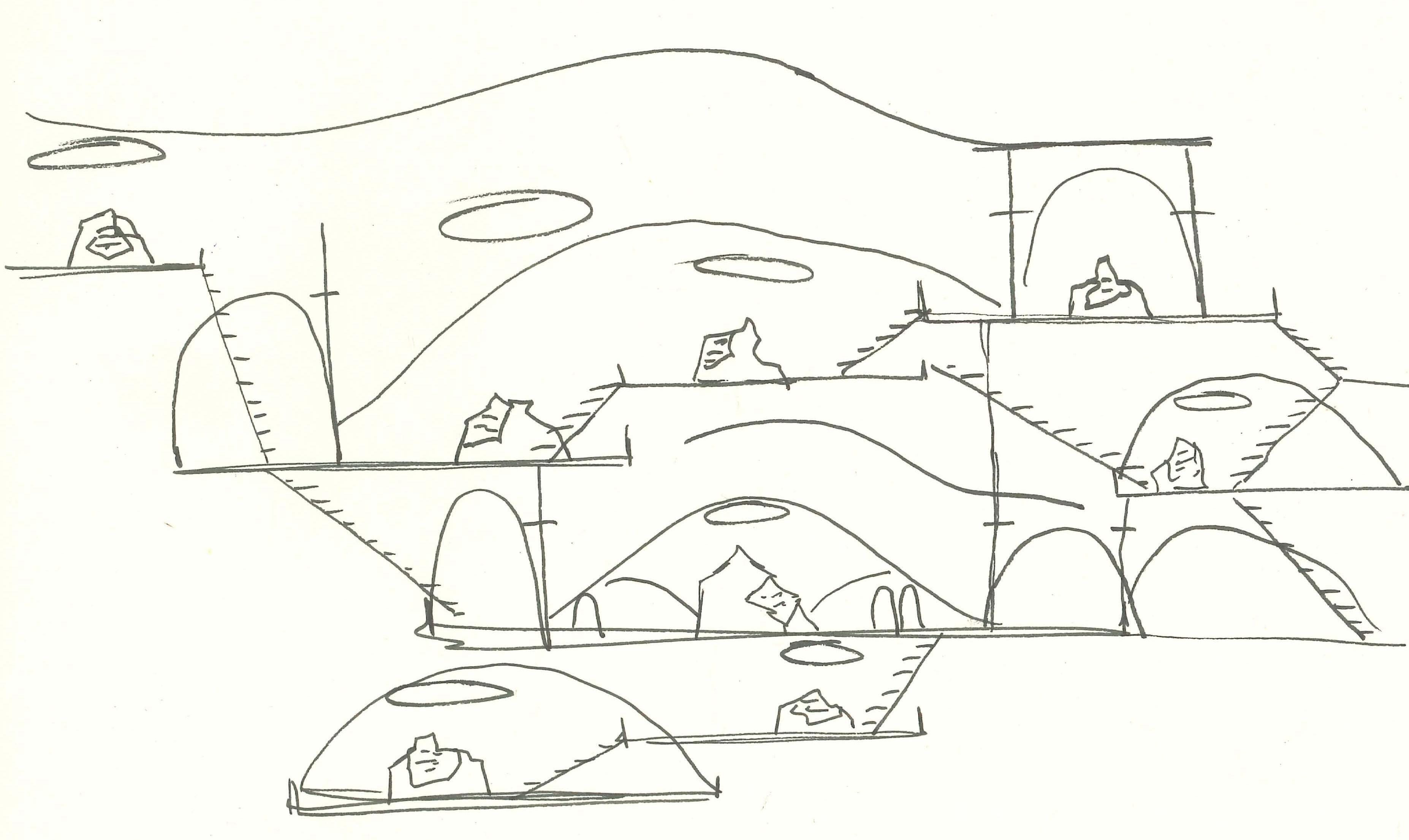
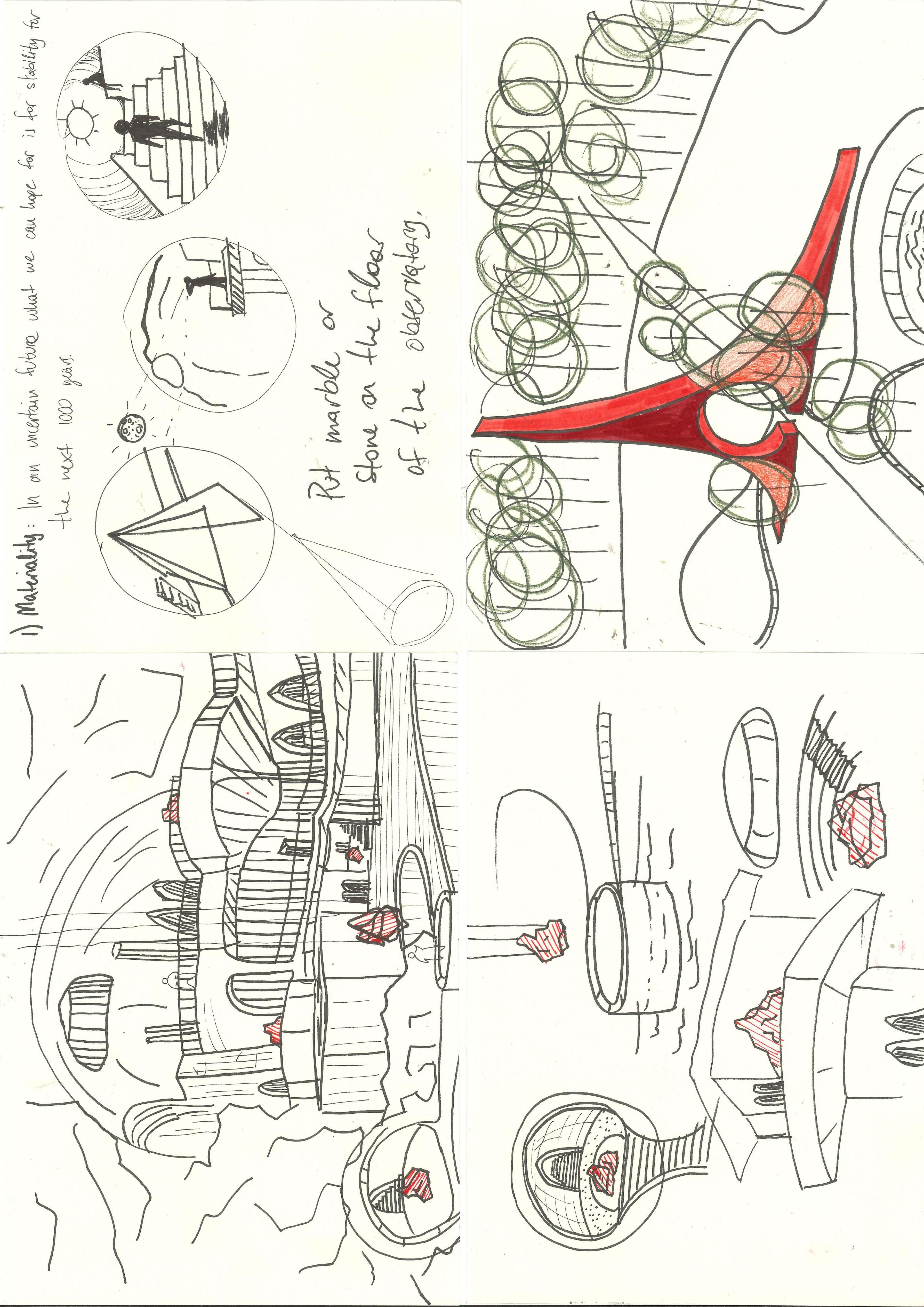

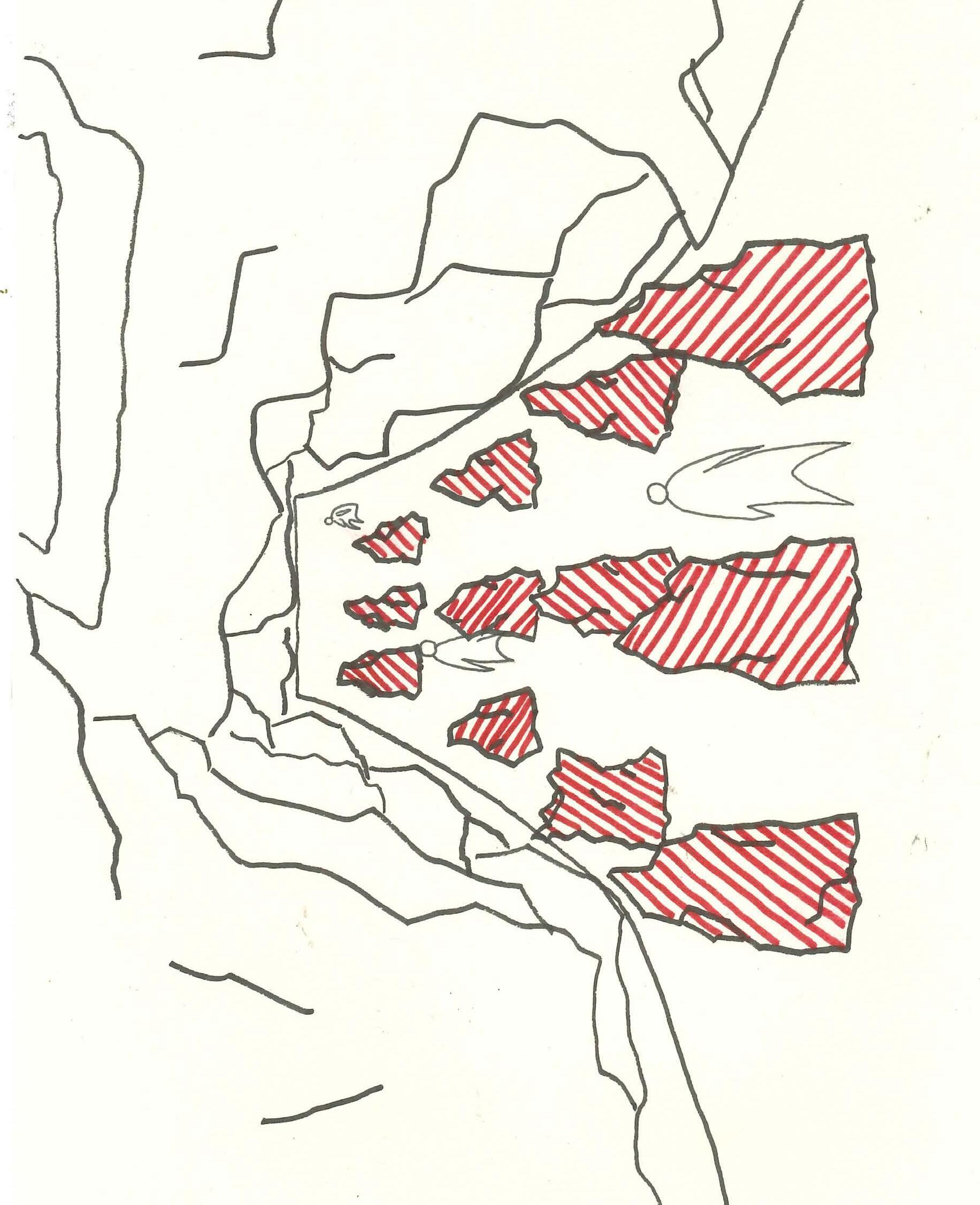

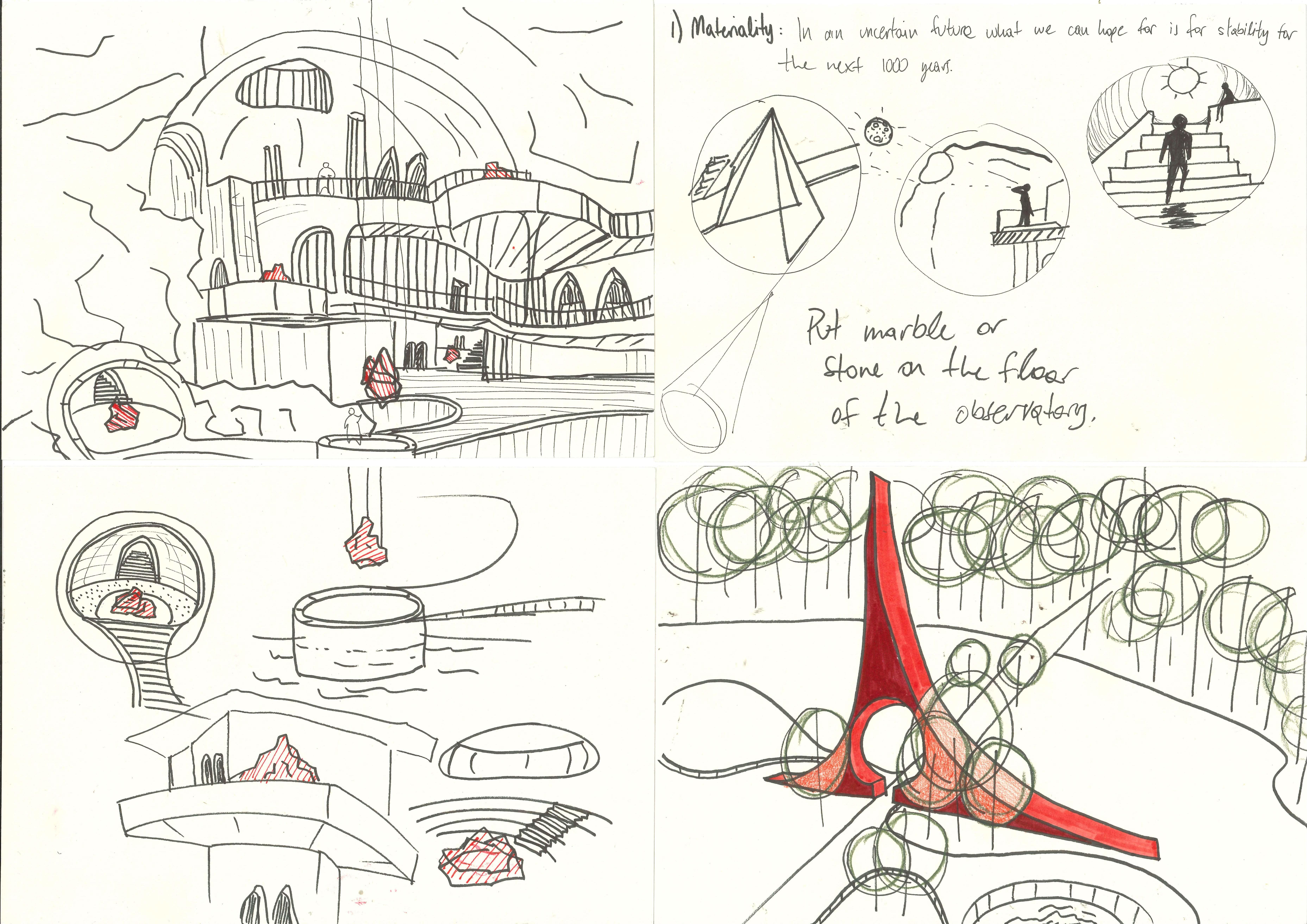

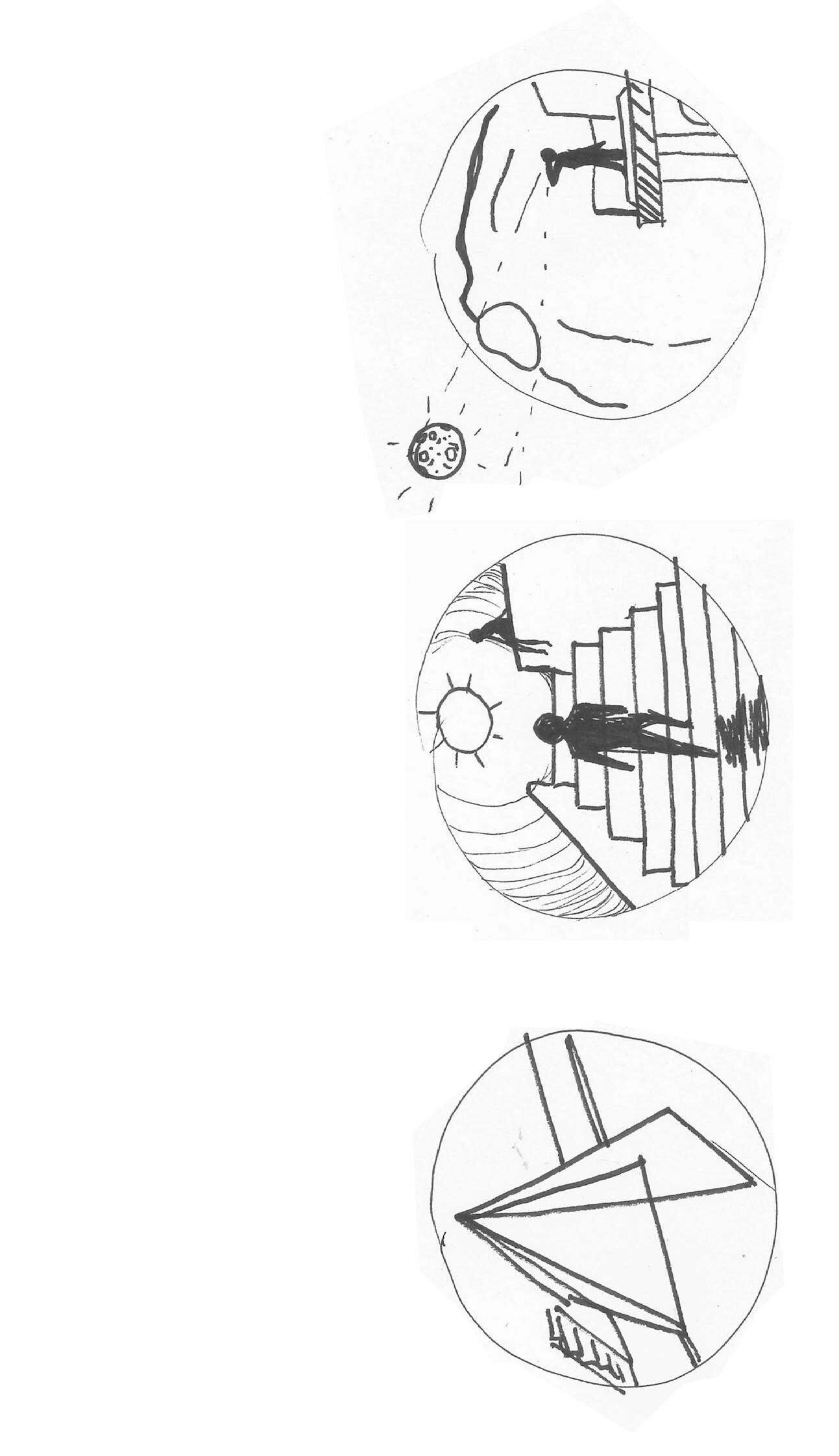
“Stone lasts. It is still the wisest deep time investment.”
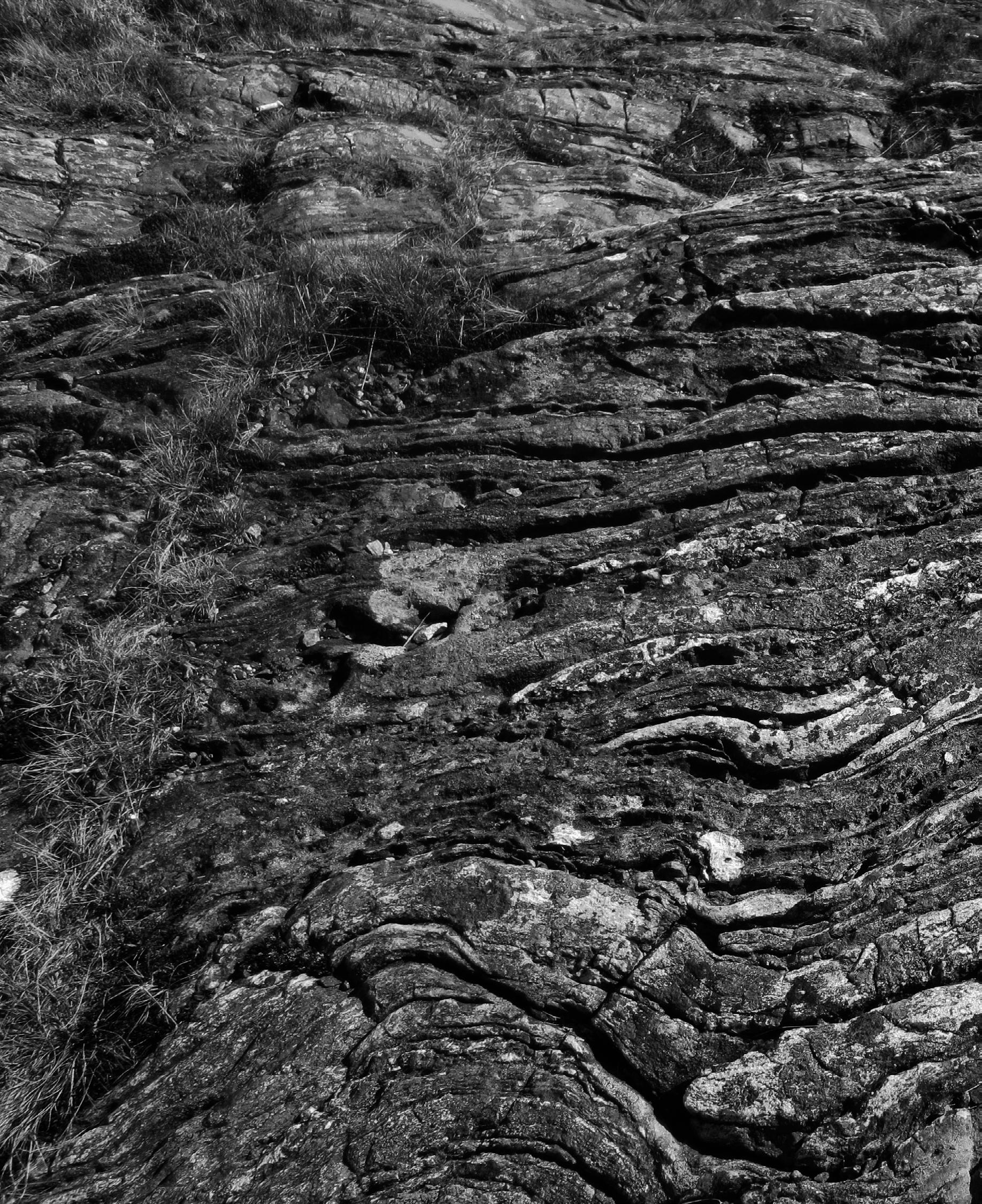
Holocene
Pleistocene
Pliocene
Miocene
Oligocene
Eocene
Paleocene
Paleocene
Jurassic
Triassic
Permian
Denovian
Silurian
Ordovician
Cambrian
Neoproterozoic
Mesoproterozoic
Paleoproterozoic
I kept circling around stones: Finland’s bedrock, ancient stone monuments, stone as a deep time investment...
The tactility and durability of rock is undeniable. In some way or the other it has existed since the beginning of the planet and carries on it its geological history. For this reason I decided to create a cavity inside the migmatite gneiss bedrock and to place inside this artificial cave a collection of stones.
Each stone is formed in a different geological epoch of Earth’s timescale and is collected from a different part of the globe. Stones, depending on the era they are formed are placed inside the Memorial of Life. The deeper inside the cave you go, the further back the stone has been formed.
Stones from the Cenozoic era are placed in the first level underground.
Stones from the Mesozoic era are placed in the second level underground.
Stones from the Paleozoic era are placed in the big chamber of the third undergound level.
Stones from the Precambrian era are placed in the rest of the -3 level and on the platforms over the water.
On each stone, there is a smoothed out part on which are inscribed the coordinates of the exact place in the world it was extracted from.
Hadean
Find a detailed catalogue of the rock formation time, type, and specific location in the appendix.
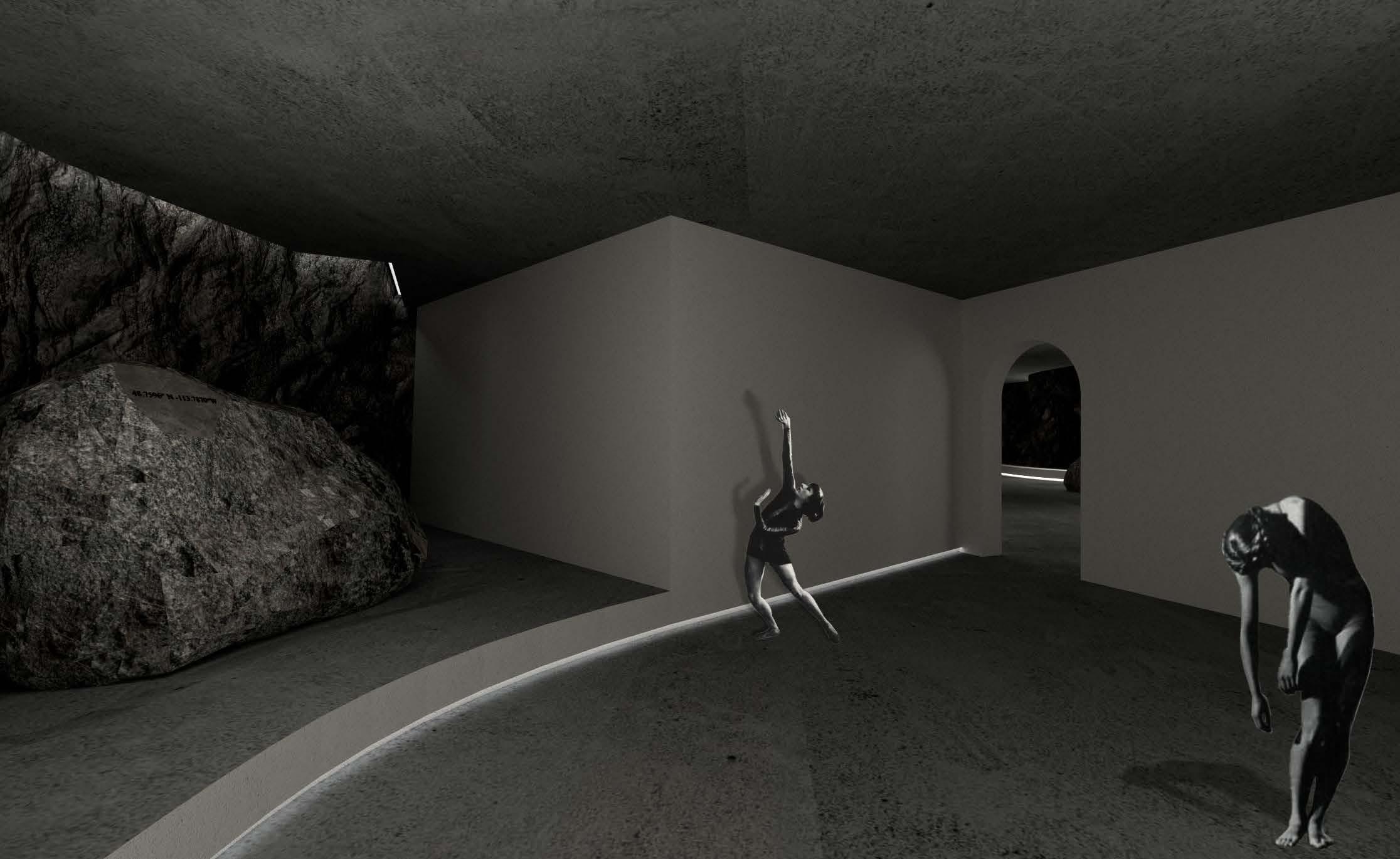
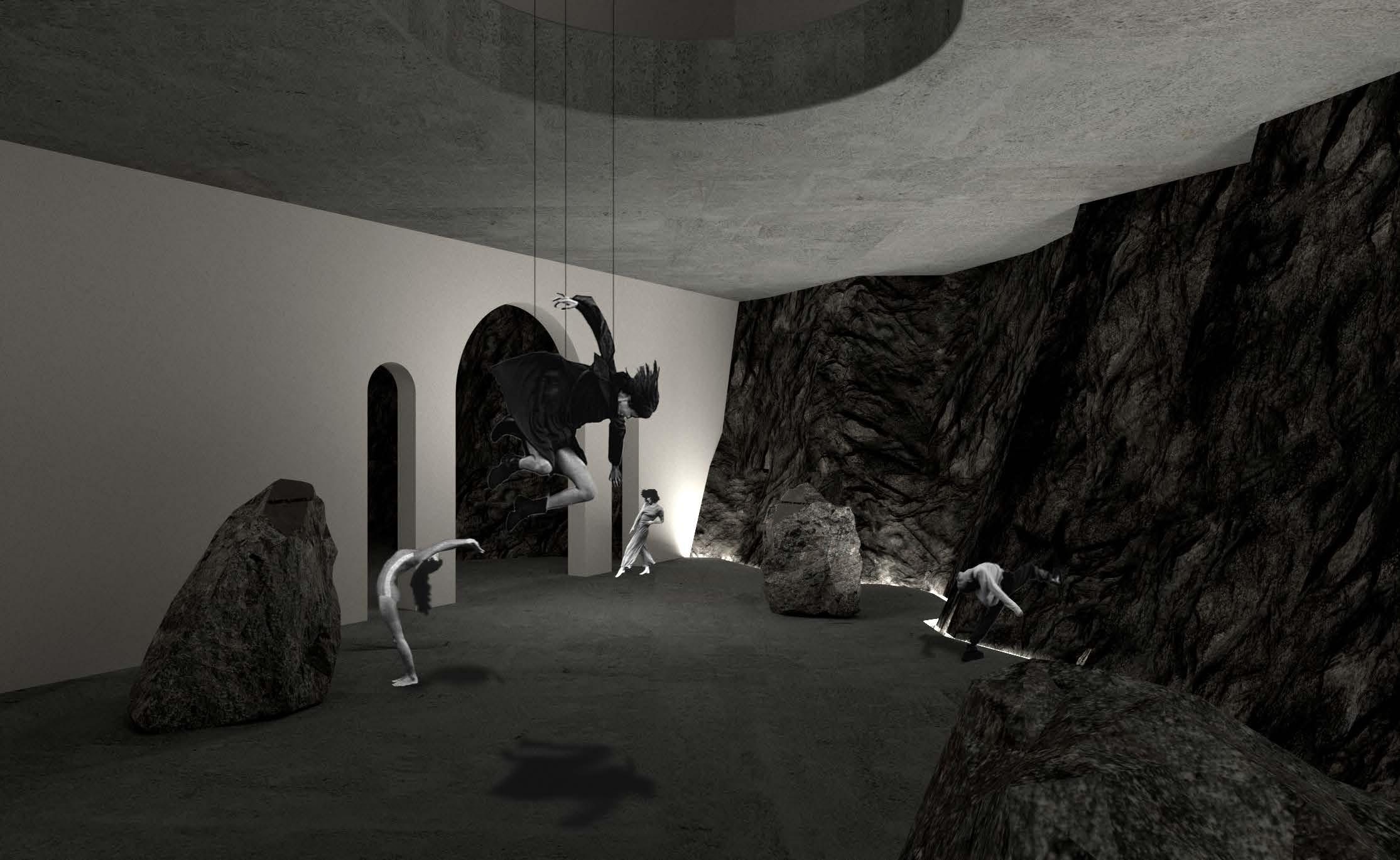

The subterranean part of the monument is accessed through a staircase oriented towards the summer solstice sunset to illuminate the exhibition with the warm sunset light.
It leads to the first basement of the structure where a stone circle on the floor indicates the optimal position for moon gazing.
A conical whole is carved in the stone to allow the field of view. The cone is defined by the maximum and minimum azimuth and maximum and minimum altitude of the full moon’s position on the day of the spring equinox, as in Finland the most appropriate weather conditions and day time-night time ratio for stargazing is during spring.


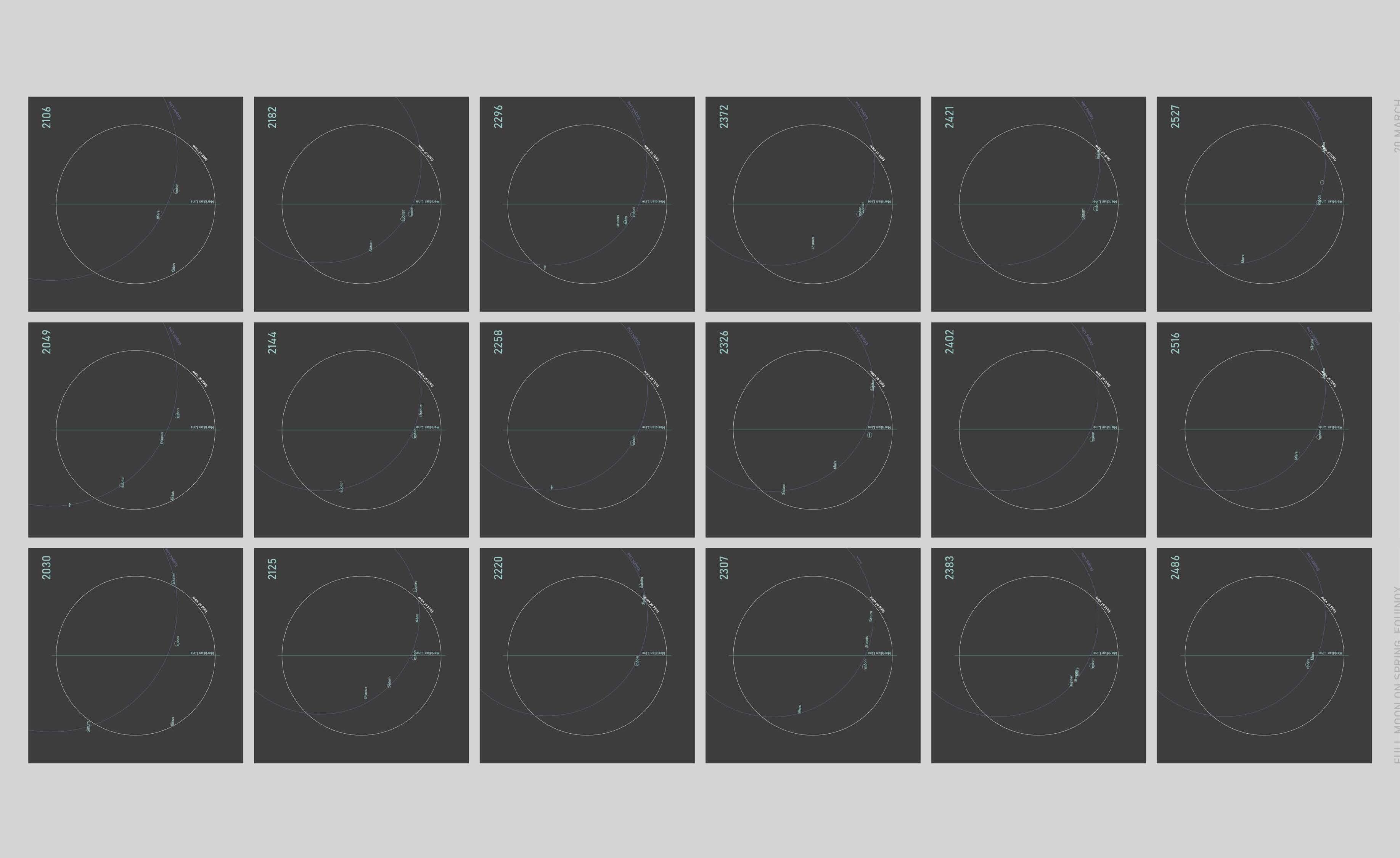
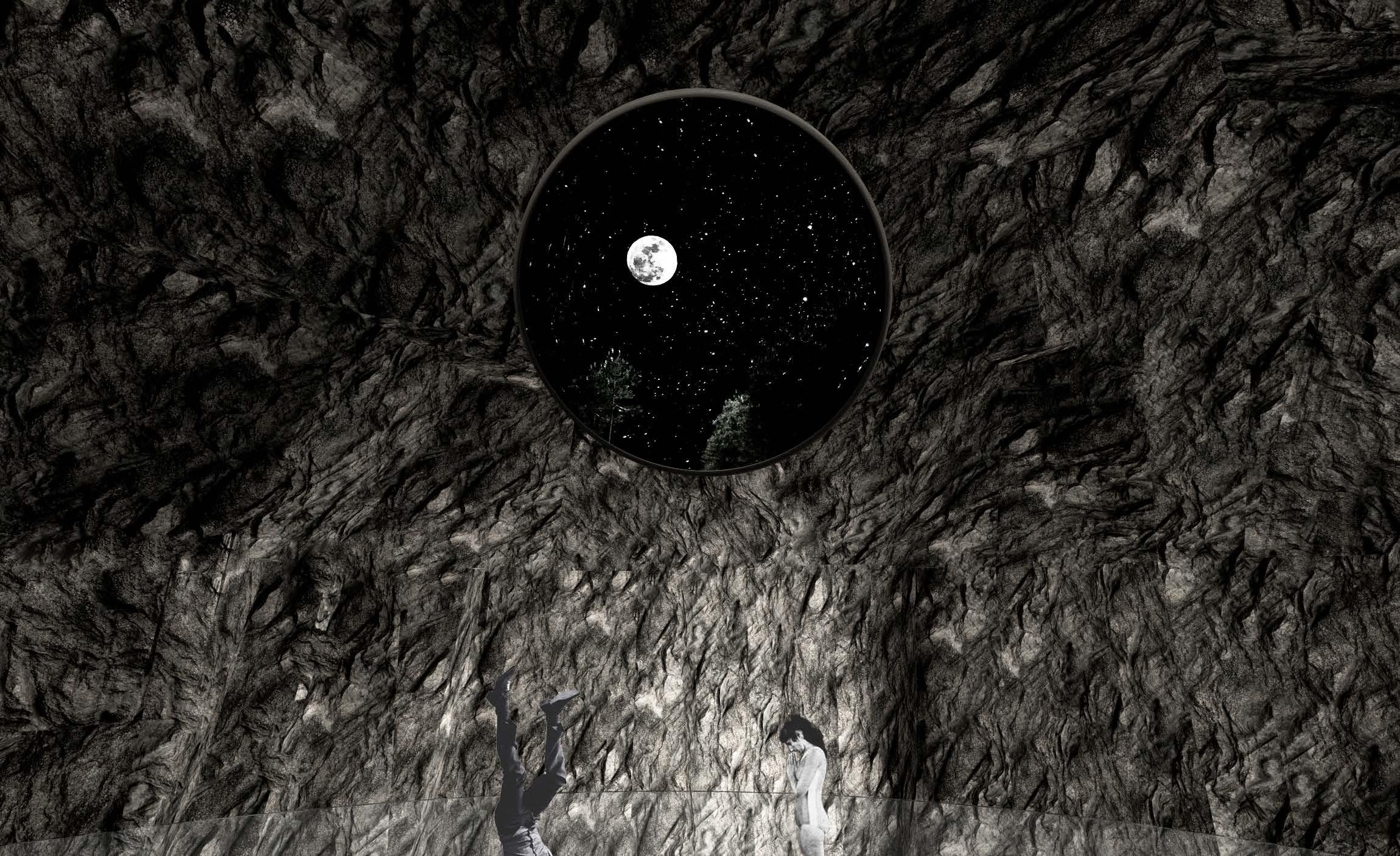

I find something very romantic in placing the Memorial of Life in proximity to Onkalo. It inspires to me a feeling of balance.
Rememberance and forgetfulness, Life and destruction, two sides of the same coin.

Kourulammi is a small fishing lake located 20km southeast from Olkiluoto. It is surrounded by pines, with the only exception being a recently deforested part. The site is hidden but can still be accessed through paths connected to the road network. The general area has another characteristic that works in favour of the design: very low depth to rockhead, which means that the bedrock in many places has low (<2m) to zero ground coverage. This same bedrock has been repeatedly tested by Posiva and its stability is certain. It is the perfect place to build something to last.



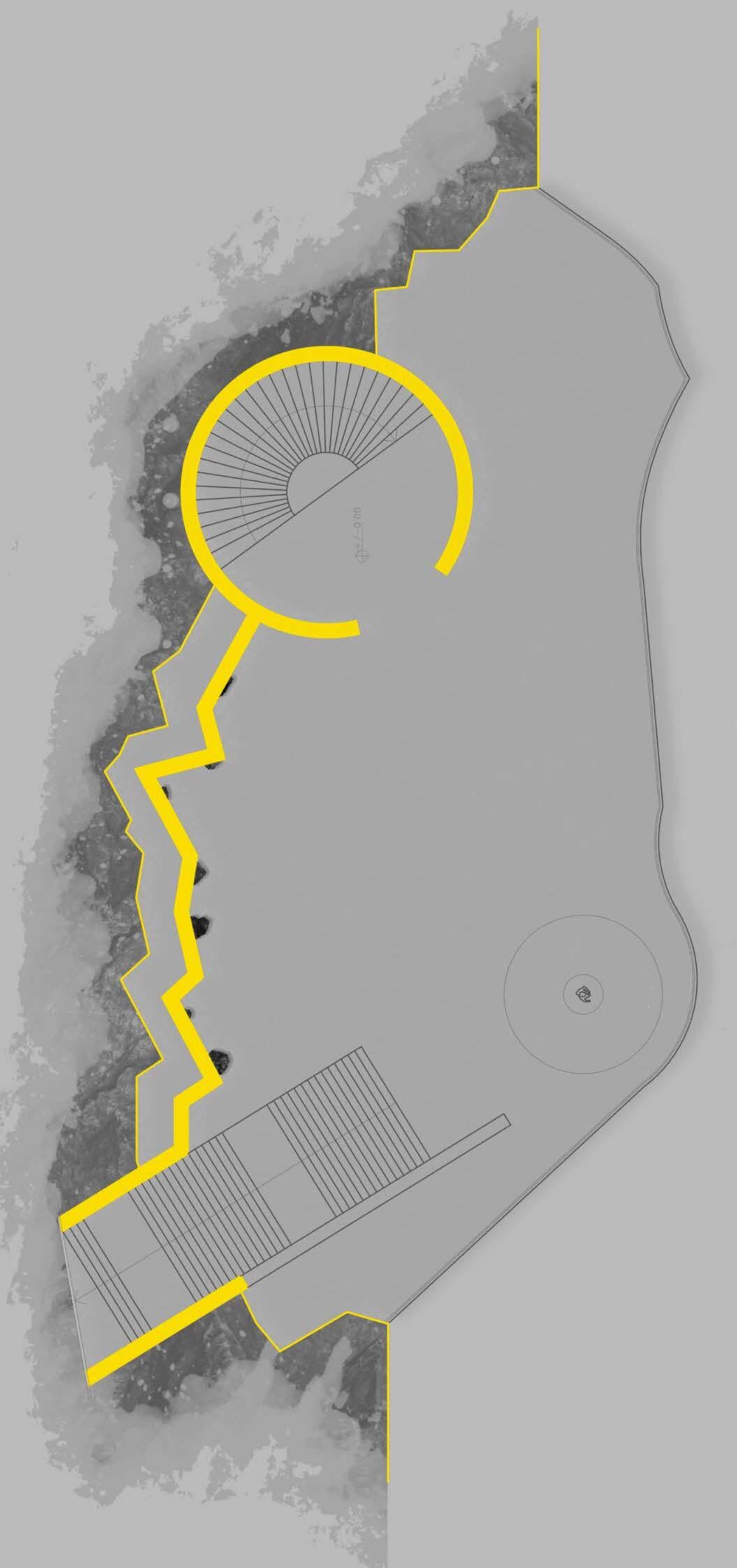


The Memorial of Life is a snapshot in time · it is designed with the current knowledge of the past and our contemporary beliefs as a guide. It is also designed to be made with materials that exist at this point in time. But in this ever changing world, there is always the possibility of new inventions that could make the Memorial of Life truly eternal.
The Memorial of Life is taking current time as year one. The timeline in which it is placed starts 10.000 years ago, when the oldest human settlement was build in Göbekli Tepe, and I aspire that it will continue to exist in some form 10.000 years from now.
What we know today will soon be irrelevant. One can only hope that our value of preserving architecture will last for at least another 500 years, given that human-induced and natural disasters will not destroy everything, everywhere before 2500CE. Taking this prediction as a given, and the fact that the ideals of monument preservation as we understand them today started forming during the Renaissance, 700 years ago, we can presume that the subterranean part of the Memorial of Life will survive as is for at least the next 500 years, through preventative and curative preservation of the concrete structure. 1⁴
After that, the underground structure, will be exposed to the natural elements and is destined to erode. Nature will reclaim the space and the stones will be buried under the rubble.
But the Monument, built using blocks of the local migmatite gneiss stone, will stand above, signaling the existence of something underneath, for those who will look for it.
14 Mallouchou-Tufano, Fani. Management and Presentation of Sites and Monuments: Historical and Theoretical approaches, Association of Greek Academic Libraries, National Technical University of Athens, 2015.


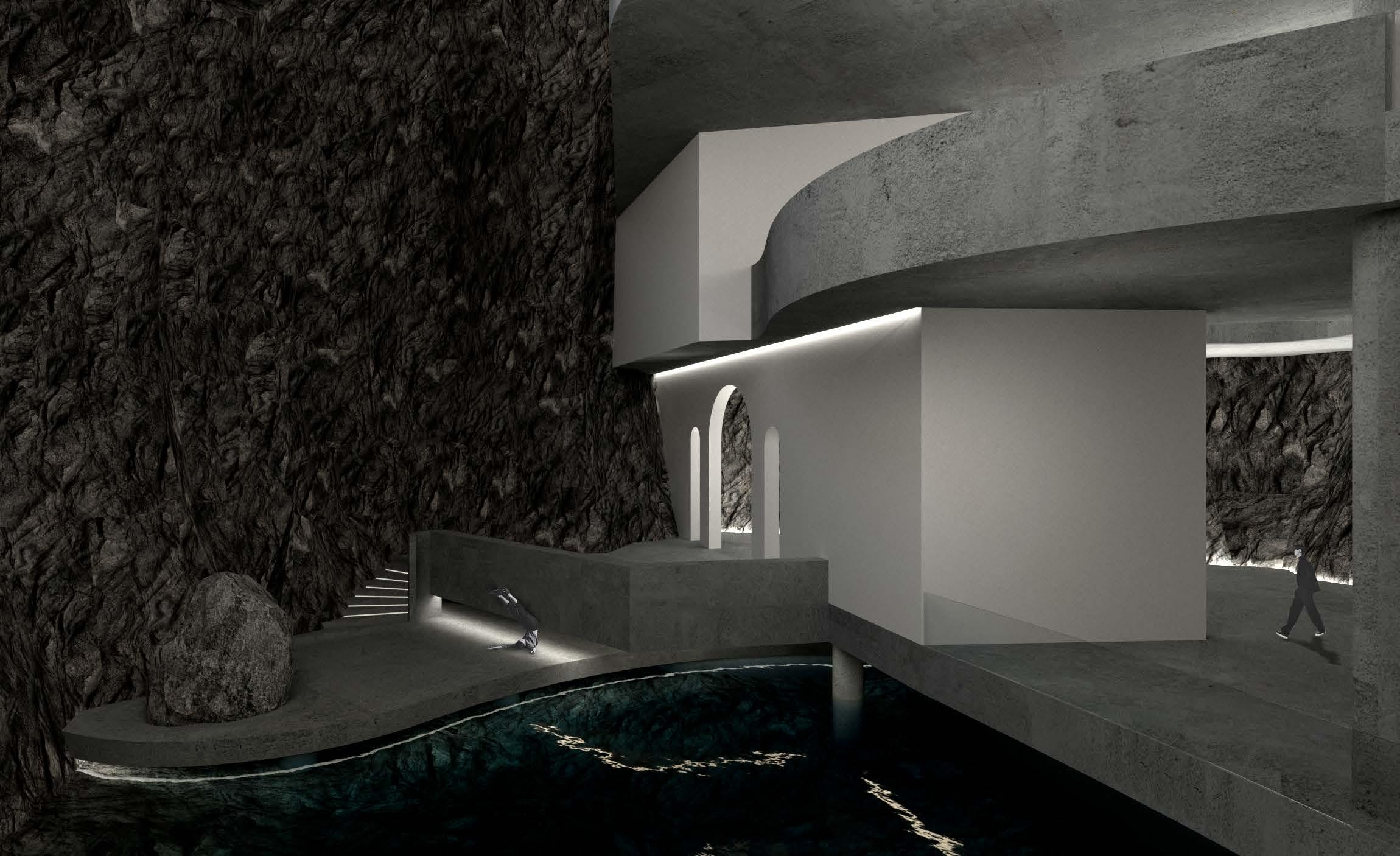

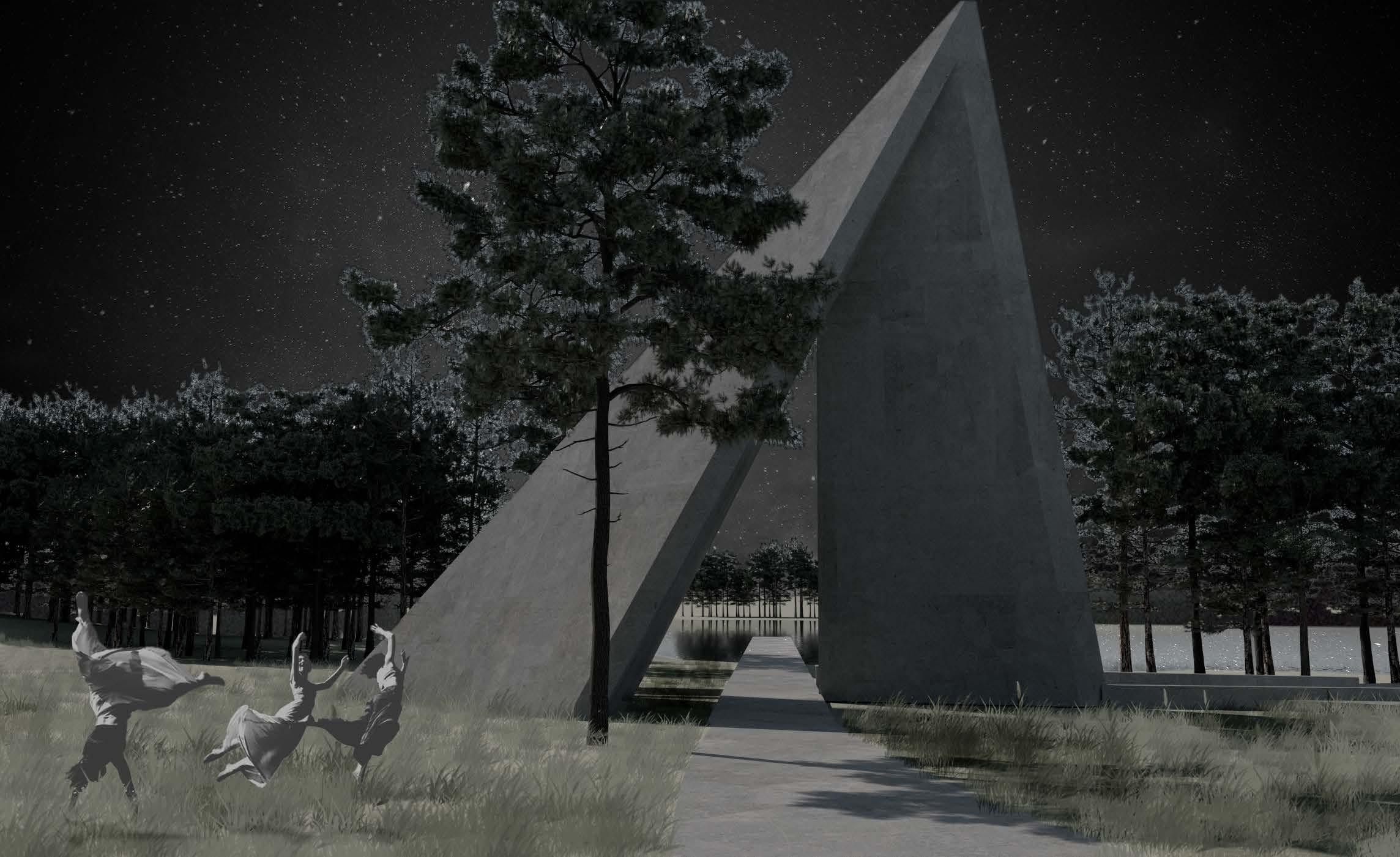
The continuous passage of time affects both our lives and the world we inhabit. In response to this unstoppable progress, humanity has striven to make its presence known, to reach down through the ages, and to create lasting monuments of its existence. This ambition to transcend the boundaries of time is central to the Memorial of Life project.
This monument will stand as a record of Earth's geological history, and a symbol of human aesthetics. The Memorial of Life will serve both a current and a future purpose.
In our time, it will function as a full moon observatory and a vault exhibiting a curated selection of stones. Observing the moon has shaped the orientation of monumental architecture for millennia, thus this project, by learning from the wisdom of the past, focuses on the position of the full moon on the day of the spring equinox for the next thousands of years. The stones, each formed in a different geological epoch, will be collected from diverse locations around the globe. This collection will not only showcase the vast timeline of Earth’s history, but also symbolize the interconnectedness of our planet’s geological heritage, acknowledging the past, the present and the future.
In the future, the Memorial of Life will serve as proof of life on this planet, an architectural testament to our existence. It is designed to speak to our deepest, subconscious human aesthetics.
Inspired by ancient monuments and contemporary challenges, the Memorial of Life not only showcases the vast timeline of Earth’s history, but also symbolizes the interconnectedness of our planet’s geological heritage.
As we face an uncertain future, the Memorial of Life will offer a tangible link to our past and a legacy for those who follow. As time passes, the monument and its contents will offer a message to future beings —whether human or otherwise— about who we were and what we valued, and it will invite them to consider their place in the universe, understand the connections between all life, and recognize the enduring mark of humanity.
Bibliography
Benford, Gregory. Deep Time: How Humanity Communicates Across Millennia. New York: Harper Collins, 1999. p.13-14.
Kahn, Louis. “Monumentality.” In Architecture Culture 1943-1968: A Documentary Anthology, p.98-102. New York: Columbia University Graduate School of Architecture, Planning and Preservation, 1993.
Lauers, Lexi. Until Eternity Falls Apart. KU Leuven, 2023.
Mallouchou-Tufano, Fani. Management and Presentation of Sites and Monuments: Historical and Theoretical Approaches. Association of Greek Academic Libraries, National Technical University of Athens, 2015.
Madsen, Michael, dir. Into Eternity. Atmo Media Network, 2010. Film.
Von Uexküll, Jakob. A Foray into the Worlds of Animals and Humans: With A Theory of Meaning. Translated by Joseph D. O’Neil. Minneapolis: University of Minnesota Press, 2013.
Websites
Deep Time.
https://anthropocene.univie.ac.at/resources/deep-time/
Geological Time Scale.
https://earthathome.org/geologic-time-scale/ https://www.geosociety.org/GSA/GSA/timescale/home.aspx
Great Pyramid of Giza.
https://en.wikipedia.org/wiki/Great_Pyramid_of_Giza
Moon placement simulator.
https://www.mooncalc.org/#/61.1416,21.8307,16/2024.03.1 3/13:43/1/3
National Land Survey Finland.
https://asiointi.maanmittauslaitos.fi/karttapaikka/?lang=en
Pioneer Plaque, Wikipedia.
https://en.wikipedia.org/wiki/Pioneer_plaque
Star simulator.
https://stellarium-web.org/
Sun placement calculator.
https://www.suncalc.org/#/61.1415,21.8303,14/2024.06.20 /03:53/1/3
The atomic priesthood project. https://www.theatomicpriesthoodproject.org/
99 Percent Invisible podcast: ten thousand years. https://99percentinvisible.org/episode/ten-thousand-years/
Voyager 1, Wikipedia. https://en.wikipedia.org/wiki/Voyager_1
Images
01. Onkalo. https://www.euronuclear.org/wp-content/ uploads/2024/01/olkiluodon_saari_ol3-laitos_ etualalla_11_3_21-scaled.jpg
02. Inside Onkalo https://gigazine.net/news/20221218finland-nuclear-waste-store/
03. Brill Michael, Abidi Safdar, Landscape of Thorns. https:// www.researchgate.net/publication/339102696_Knowledge_ Preservation_for_Nuclear_Waste_Repositories/figures?lo=1
04. The atomic priesthood https://www. theatomicpriesthoodproject.org/
05. Giant’s Church. https://crop.kaleva.fi/ S3zgYYvzTYiEqxnicMcsHRfYHsw=/2600x1732/smart/ https%3A//lorien-media-prod.s3.amazonaws.com/migration/ kalevafi/i/2019/09/14/4216086-r-6299b.jpg
06. Jelitto, Hans. Planetary Correlation of the Pyramids at Giza and Teotihuacán ‒ P5 Program Description 2022
07. Darvill, Timothy. Figure 1. Plan of Stonehenge, showing the principal structural features (after Darvill 2006), Stone henge Remodelled, 2012, Antiquity, 2012.
08. Migmatite Gness. https://commons.wikimedia.org/wiki/ File:Krsand_Kvarenesodden_geologi_IMG_3712_migmatitegneiss.JPG
09. Moon. https://en.wikipedia.org/wiki/Moon#/media/ File:FullMoon2010.jpg
The Memorial of Life serves both a current and a future purpose.
In our time, it functions as a full moon observatory and a vault exhibiting a curated selection of stones. Observing the moon has shaped the orientation of monumental architecture for millennia, thus this project, by learning from the wisdom of the past, focuses on the position of the full moon on the day of the spring equinox for the next thousands of years. The stones, each formed in a different geological epoch, are collected from diverse locations around the globe. This collection not only showcases the vast timeline of Earth’s history, but also symbolizes the interconnectedness of our planet’s geological heritage, acknowledging the past, the present and the future.
In the future, the Memorial of Life will serve as proof of life on this planet, an architectural testament to our existence. It is designed to speak to our deepest, subconscious human aesthetics.
As the centuries and millennia pass, the monument and its contents will offer a message to future beings —whether human or otherwise— about who we were and what we valued.
© The images, graphs and text created by the author, excluding the citated text and referenced images, are owned by the author. Any reproduction or representation of those, in whole or in part, in any form and in any manner whatsoever, is prohibited without the prior written consent of the author.

Maria
Michelaki 2023-2024
Studio Sv-On-Po-Gi
KU Leuven Faculty of Architecture
Campus Sint-Lucas Brussels